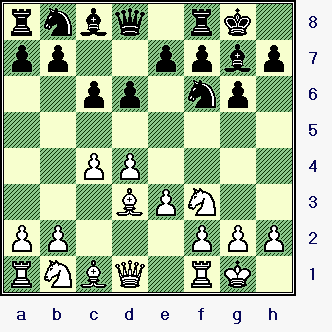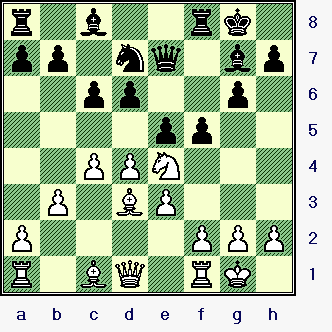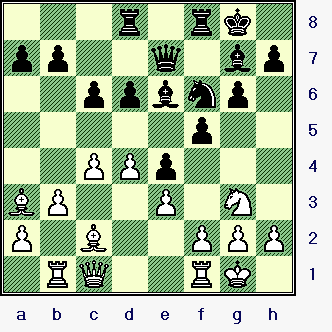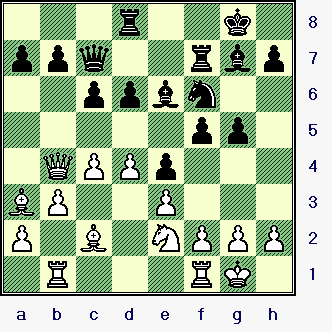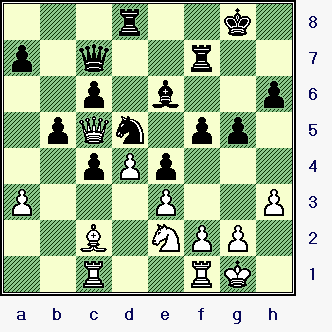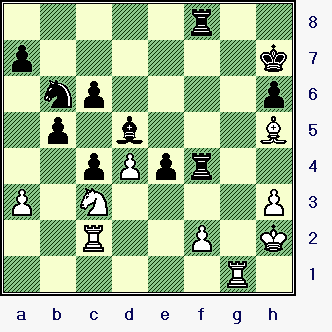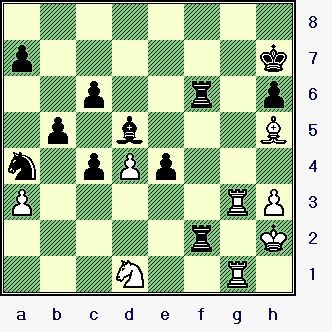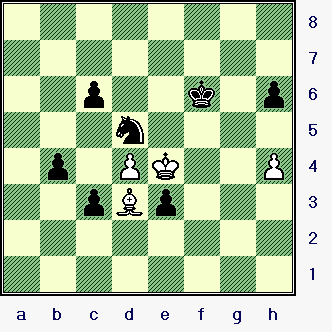All
the |
(Navigation bar
directly below.)
*******
© A.J. Goldsby, 2015.
(All rights reserved.)
****************
Click HERE
to see my
Chess Items.
****************
****************
Buy a book
from Amazon.com
(And help me out as well!)
****************
Click HERE
...
to see a list of the businesses that help to sponsor all of
my chess efforts.
A blindfold game of mine.
I have mentioned many times that I could play blindfold chess.
Bart Heikimian (at our club) will readily tell you of a night at one of our meetings, 5-10 years ago. I played seven games of blindfold chess, simultaneously. The only person who managed to beat me was Bart. Jack Mallory might also remember when I played three of the better scholastic players at the (Mobile Chess) club a few years back. I played three games both blindfold and simultaneously. One of the games featured a Queen sacrifice, and I chased my opponent's King over to the edge of the board and I mated him. (Somewhere over on the Queenside - I won all three games.)
When I tell people of these feats, I am always asked for proof. OR ... people ask me for one of my games, (that I played blindfold). I never have written them down, usually other people do that for me. But I have had more than one e-mail requesting to see one of my blindfold games.
So ... it has been in my mind ... for the last 2-3 years ... to play a blindfold game of chess, record it, and then post it on my website. Most of the times, I don't really have the opportunity, but on this night things were very slow ... and everyone seemed to have a playing partner but me. (There were plenty of witnesses, Bart, Don, Earl, Billy, and several people that I don't really know their names. And after the game, my friend Stephen Davis was nice enough to take me over to the "Steak-n-Shake" and help me remember ... and reconstruct the game.)
Click HERE to see an explanation of the symbols that I use when annotating any chess game.
Note of explanation: As my opponent is not a super-GM, I have not 'graded' this game as strictly as I might have done, otherwise. I have tried to be relatively objective, you may look to see how many exclams that I have awarded to my own play here. (The PRIMARY purpose of this whole endeavor was to simply show that I could - and, of course - that I still can - play blindfold chess.)
Mike Banks (1350) - A.J. Goldsby I
(2250)
|
|
|
rnbq1rk1/pp2ppbp/2pp1np1/8/2PP4/3BPN2/PP3PPP/RNBQ1RK1 w
My last move was played out of a desire to create a rather unusual position ... and get as far away from the book as possible. (In case my opponent was familiar with all of the so-called 'normal' lines.)
[
More common would be: 6...Nbd7;
7.Be2 e5; 8.Nc3 Re8; 9.b4, "~"
when White might still have a very small advantage here.
GM Manuel Rivas-Pastor (2505) - GM Anatoly Karpov (2740);
[E61]
Super-Master Tournament /
Dos Hermanas, GER; (R#1) /
04,1994.
{Drawn in 37 moves.} ]
7.Nc3 Nbd7;
8.Nd2!?,
White probably wanted to get in f4.
[ Better was the move of >/= 8.Qc2, "+/=" when White has a small, but solid plus. ]
8...e5;
9.Nde4!?, (Possibly dubious?)
I see the club members play this line all the time. This is not the best way to play this position, exchanges {at this point} only help Black.
[ The safest line for White was probably the continuation:
9.d5 Nc5; 10.Be2 a5;
"=" when both sides have a perfectly
playable position here. (Very much like a King's Indian Defense.)
]
9...Qe7;
10.b3!?,
White - understandably - wants to get his QB into the game ... as it is currently shut out. However, this is less than best, 10.Ng3 was probably White's best bet here.
10...Nxe4;
11.Nxe4?!,
White is losing his grip on the game with this move.
[ >/= 11.Bxe4 f5; 12.Bf3 Qh4; "=/+" ]
11...f5;
"/+" {See the
diagram just below.}
Black already has an advantage in this position ... in fact, if Black chooses to, he can win a Pawn from
here.
|
|
r1b2rk1/pp1nq1bp/2pp2p1/4pp2/2PPN3/1P1BP3/P4PPP/R1BQ1RK1 w
Now White's best move is probably Nd2, the g3-square in an inferior post, and this steed will be left out for some time to come.
12.Ng3!?,
('?!') 12...e4!?;
('?')
Technically, this move is an error ... it was better to grab the Pawn on d4.
This was not an oversight, but a simple case of not taking the time to analyze the board properly. (I suspected some sort of hidden trap ... that was not really there.) Also, I was a little rusty on my blindfold skills. At the beginning of the game, I could not see the board, (in my head); really well, and was overly nervous. But by move twenty, I began to get into the game, and also relax just a little bit.
[ >/= 12...exd4; 13.exd4 Bxd4; "/+" ]
The next series of moves does not require a lot of comment.
(Both sides continue to try and get all of their pieces out.)
13.Bc2 Nf6;
14.Ba3 Be6;
15.Rb1 Rad8; 16.Qc1!?, {See the
diagram just below.}
White seems to be just shifting his pieces back and forth, and is playing chess without a comprehensive plan.
|
|
3r1rk1/pp2q1bp/2ppbnp1/5p2/2PPp3/BP2P1N1/P1B2PPP/1RQ2RK1 b
I thought that White had to undertake a major re-arrangement of his pieces in this position.
(Qd2, Ne2-c3, Bd1-e2, and then Rfc1.)
[ (>/=) 16.f3!? ]
16...Rf7;
I continue to clear the a3-f8 diagonal, the White Bishop on a3 makes me nervous.
[ A lot better was:
>/= 16...Ng4!;
"/\" followed by playing my Queen to the
h4-square, (with a strong
attack). ]
17.Ne2 g5;
This was obviously played to prevent White from getting his Knight to the (good) f4-square.
(17...Ng4 was also worth some thought here for Black.)
18.Qe1!?,
White continues to shift his pieces around the board.
[ Maybe 18.Qd2, instead? ]
18...Qc7;
19.Qb4!?, {See the
diagram just below.}
I don't know about this move, White is walking into a potential haymaker, a GM would never play this way.
|
|
3r2k1/ppq2rbp/2ppbn2/5pp1/1QPPp3/BP2P3/P1B1NPPP/1R3RK1 b
White should push his f-Pawn in this position, either one or two squares.
(In an attempt to halt Black's ideas of King-side expansion.)
[ It is quite possible that the move of
(>/=) 19.f3,
was close to
being forced
for White in this position. ]
19...d5;
20.h3?!,
This is a very crucial turning point in the game ... White had to play f3 or even f4 in this particular position.
20...Bf8;
I thought this was best, but the <possible> advance of my f-pawn was also worth
some very serious consideration at this point.
21.Qc3?,
['??'] (A blunder?)
Without question, this is a very bad move, White now loses a piece. [He can {then} get the piece back by trapping the Black Bishop, but this whole procedure costs White two precious Pawns.]
The real kicker is White had TWO different moves that would have prevented the loss of a piece.
[ >/= 21.c5[] f4; "/+" ]
21...Bxa3;
22.b4[], {Box.}
Now this is forced, otherwise White remains a piece down for absolutely no compensation at all.
[ </= 22.c5?? a5; "-/+" ]
22...Bxb4;
23.Qxb4 dxc4;
24.a3 Nd5!?; 25.Qc5!?, ('?!')
White's Queen is placed on a risky square here. Without going into too much detail, White - who is down a fair amount of material - needs to avoid an exchange (of the ladies) at all costs.
[ Probably the safest is:
25.Qb2, but not
</= 25.QxP/c4??
Nc4;
"-/+"
winning easily for Black.
]
25...b5;
This helps to protect my advanced (passed) Pawn on c4 ... my Queen now (also) protects my QRP, which was being threatened with capture as well.
26.Rbc1 h6;
(Why this move?) {See
the diagram just below.}
I thought for a seeming eternity here, and I calculated several different lines.
|
|
3r2k1/p1q2r2/2p1b2p/1pQn1pp1/2pPp3/P3P2P/2B1NPP1/2R2RK1 w
Once again ... without going into too much detail, or providing reams of analysis ... I had calculated a long line. My Queen was going to wander off and (maybe) capture the a-Pawn. {I also had to move my Knight on d5 in this line as well.} White - then - would have the tactic of playing BxP/e4! If I capture the Bishop, White plays QxP/g5+ followed by QxR/d8.
All this does not change the fact that ...P-QR4 was the much better move, and the computer confirms this fact.
[ >/= 26...a5!; "/+" (Maybe "-/+") ]
27.Bd1 Qb6;
Being two Pawns up, I wanted the Queens off the board - and as quickly as possible. (This is normally a good idea for the player who is trying to play without sight of the board.)
[ MUCH better was:
>/= 27...f4!;
"--->" when Black's attack is both powerful
and probably decisive.
]
28.Qxb6 Nxb6!?;
29.Nc3 Bd5!?;
Trying to get my Bishop back into the game ... but now my Knight (on b6) is somewhat out of play here.
[ The box prefers to play
29...Nd5;
but the difference between the two
moves is not really all that big or substantial enough to worry about.
]
30.Bh5 Rf6;
31.g3!? Kh7; 32.Kh2 Rg8; 33.Rc2 f4; ('!?')
I was sure when I played this move, that I could praise my accuracy and my aggressiveness, yet there was an easier solution.
[ Once more, the move of:
>/= 33...a5!;
("/+"
or "-/+") is both the simplest and the best.
(And Fritz 9 confirms this.)
]
The next few moves look forced.
34.gxf4,
White cannot allow Black to capture on the g3-square here.
[ </= 34.exf4 gxf4; 35.Re2?? fxg3+; 36.Kg2 gxf2+; 37.Kh2 e3; "-/+" ]
34...gxf4;
35.exf4, [
(>/=) 35.Rg1
]
35...Rxf4; 36.Rg1 Rgf8!?; {Diagram}
Good or bad, I seem to seek - (and find!) - complications, even when the simplest and
sanest course of action is to simply trade pieces.
|
|
5r2/p6k/1np4p/1p1b3B/2pPpr2/P1N4P/2R2P1K/6R1 w
This is the current situation - that we now have - on the chess board.
[ The machine says that Black's best and safest line is:
36...Rxg1;
37.Kxg1
Rh4; 38.Bg4 Kg6; 39.Kh2 h5; 40.Kg3 Kg5;
41.Be2 Nc8; "-/+"
when the second party has an overwhelming position.
]
(Now) 37.Rg2 might be best, (here - for White); at least according to Fritz.
37.Nd1 R8f6!?;
To guard g6.
[ >/= 37...Bf7!; "-/+" (Or even 37...a5.) ]
38.Rc3 Na4!?;
('!')
Pushing the QRP (two squares) was probably the safest course of action here for Black ... but I preferred to (try and) force the situation.
39.Rcg3,
{See the diagram just below.}
This is practically the only good move for White.
|
|
8/p6k/2p2r1p/1p1b3B/n1pPpr2/P5RP/5P1K/3N2R1 b
I knew that in this position, with my opponent having two doubled Rooks and a Bishop near my King ... that one false step was fatal.
[ </= 39.h4?? Nxc3; "-/+" ]
Now Black decides on a sacrifice.
39...Rxf2+!?,
hmmmm
I was hoping that Fritz would verify this as the best move. Then I could give it two exclams, and praise my blindfold skills to the skies.
However, I tested this position on several different programs. My move, (the rook capture on f2); is not the first second ...
or even the third choice of most programs. (This means that my sack was not really best, or even necessary.)
[ Fritz prefers: (>/=) 39...Kh8; 40.R1g2, etc. (White is still quite lost.) ]
The next few moves are forced.
40.Nxf2 Rxf2+;
41.R1g2, ('!?')
Interposing with the other Rook might have been a little better.
[ But not: </= 41.Kh1? e3+; 42.R1g2 c3!; "-/+" when Black is winning easily. ]
41...e3;
42.Rg7+?!,
This is definitely not a good move, after this play by White, Black's edge nearly doubles.
(Maybe this is a case of the old saw, "Patzer see a check, Patzer take a check?")
Not only this, White has the chance to set a clever trap ... and go for a draw.
{See the note just below.}
[ White's only hope was to play for:
>/= 42.Bg6+ Kh8;
43.Be4! Bxe4?;
Now this is a mistake for the second player.
(The move of 43...RxR/g2+; still wins
("-/+")
easily for Black.)
44.Rg8+ Kh7;
45.R8g7+ Kh8;
46.Rg8+ Kh7; 47.R8g7+ Kh8;
"="
The game is drawn because Black cannot escape the checks.
]
42...Kh8;
43.R7g6 Bxg2;
44.Rxg2,
Too routine.
With correct play, White is still losing ... no matter what. But here, he had a chance to win a Pawn with a clever tactic.
[ A little better was: >/= 44.Rxh6+! Kg7; 45.Rg6+ Kf8; 46.Rxg2, etc. ]
44...Rxg2+;
This wins pretty easily, yet I missed a much fancier win here.
[ A whole lot sharper was:
>/= 44...c3!!;
45.Bg6 Rd2!;
46.Kg3,
(Or 46.Bb1 e2; "-/+")
46...e2!;
"-/+" when Black wins instantly.
(The point is found
after 47.Kf2, when
47...e1(Q)+ wins White's Rook.)
]
45.Kxg2 c3!?;
46.Bg6 Nb6;
47.Kf3 Kg7; 48.Be4 Kf6;
49.Bd3, ('!?')
Best was taking the Pawn, (Kxe3); although Fritz shows that Black wins easily with ...Nd5+;
followed by ...Kg5.
[ But of course NOT the move:
</=
49.Bxc6??,
when the simple 49...c2;
wins ("-/+") handily for Black.
]
The rest is pretty easy to understand, White was not going to escape here anyway.
49...Nd5;
50.h4 a5; 51.Ke4? b4!?;
Good enough ...
(I did not want to sack my Pawns.)
[ Immediately decisive was: >/= 51...c2!; 52.Bxc2 e2; etc. ]
52.axb4 axb4; ("-/+") (White Resigns, see the final diagram, just below.)
|
|
8/8/2p2k1p/3n4/1p1PK2P/2pBp3/8/8 w
And here my opponent realized that the game was pretty much lost, and decided not to continue the battle.
This was not a bad blindfold game, and I decided to present it in its entirety.
(If you look closely, you will see I did not award myself a single exclam.)
Copyright (c) A.J. Goldsby, 2006. All rights reserved.
0 - 1
|
Click HERE to - go to or return - to my HOME PAGE ... for this site. Click HERE to go (or return) to my site map (page). Click HERE to go (or return) to the Geo-Cities page for My Games. Click HERE to go (or return) to my "Annotated Games I" (page). Click HERE to go (or return) to my "Annotated Games II" (page). (Or you could use the "Back Button" on your web browser.) Copyright (c) LM A.J. Goldsby I Copyright (©) A.J. Goldsby, 2015. All rights reserved. ******* This page was first created in early April, 2006. It was first posted: 04/07/2006. It was last updated on: February 12, 2015 01:12 PM . |
